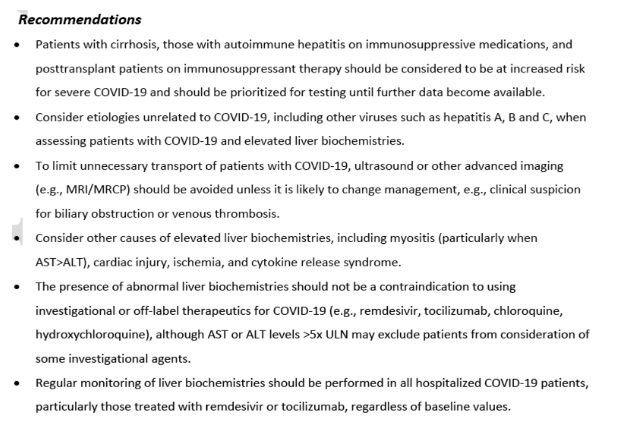| |
|
Clinical Best Practice Advice for Hepatology and Liver Transplant Providers During the COVID‐19 Pandemic: AASLD Expert Panel Consensus Statement
|
| |
| |
Download the PDF here
First published: 16 April 2020
"Therapeutic agents used to manage symptomatic COVID-19 may be
hepatotoxic, including remdesivir and tocilizumab. Less common causes of elevated liver biochemistries include chloroquine, hydroxychloroquine, and azithromycin.
Regular monitoring of liver biochemistries should be performed in all hospitalized COVID-19 patients, particularly those treated with remdesivir or tocilizumab, regardless of baseline values.
Patients with cirrhosis, those with autoimmune hepatitis on immunosuppressive medications, and posttransplant patients on immunosuppressant therapy should be considered to be at increased risk for severe COVID-19 and should be prioritized for testing until further data become available."
https://doi.org/10.1002/hep.31281
https://aasldpubs.onlinelibrary.wiley.com/doi/abs/10.1002/hep.31281
Abstract
Coronavirus disease 2019 (COVID‐19), the illness caused by the SARS‐CoV‐2 virus, is rapidly spreading throughout the world. Hospitals and healthcare providers are preparing for the anticipated surge in critically ill patients but few are wholly equipped to manage this new disease. We all must do our part to prepare our patients, clinics, and hospitals for the drastic changes necessary to mitigate the spread of SARS‐CoV‐2 or we risk overwhelming the capacity of our healthcare system. The goals of this document are to provide data on what is currently known about COVID‐19, and how it may impact hepatologists and liver transplant providers and their patients. Our aim is to provide a template for the development of clinical recommendations and policies to mitigate the impact of the COVID‐19 pandemic on liver patients and healthcare providers.
excerpts see full attached pdf doc
Effects of SARS-CoV-2 on the Liver and Evaluation of COVID-19 Patients with Elevated Liver Biochemistries
The novel coronavirus SARS-CoV-2 is most similar to the beta-coronaviruses, SARS-CoV and MERS-CoV, the
causative agents of the SARS outbreak in 2002-2003 and the MERS outbreak beginning in 2012, respectively.
SARS-CoV-2 is a single, positive-stranded RNA virus that replicates using a virally encoded RNA-dependent RNA polymerase. SARS-CoV-2 binds to and is internalized into target cells through angiotensin-converting enzyme 2 (ACE2), which acts as a functional receptor.(8,9) ACE2 is present in biliary and liver epithelial cells; therefore, the liver is a potential target for infection.(10) The incidence of elevated serum liver biochemistries in hospitalized patients with COVID-19 ranges from 14% to 53%.(1,11–15) AST and ALT are primarily elevated in COVID-19, generally 1-2 times the upper limit of normal (ULN), with normal to modestly elevated total bilirubin levels early in the disease process. Liver injury occurs more commonly in severe COVID-19 cases than in mild cases, and rare cases of severe acute hepatitis have been described.(11,15,16) Liver injury in mild COVID-19 cases is usually transient and does not require specific treatment.(15) In addition to other markers of disease severity such as lymphopenia and D-dimer, low serum albumin on hospital admission is a marker of COVID-19 severity.(14,17,18)
Liver histologic assessment has been limited but thus far is nonspecific and ranges from moderate microvesicular steatosis with mild, mixed lobular and portal activity to focal necrosis.(21,22) Elevated liver biochemistries may reflect a direct virus-induced cytopathic effect and/or immune damage from the provoked inflammatory response.(12,23) Therapeutic agents used to manage symptomatic COVID-19 may be hepatotoxic, including remdesivir and tocilizumab. Less common causes of elevated liver biochemistries
include chloroquine, hydroxychloroquine, and azithromycin.
It is unknown whether patients with chronic liver disease, especially viral hepatitis B and/or C, are more susceptible to liver damage from SARS-CoV-2, as was the case with SARS-CoV.(14) It is also unknown whether
SARS-CoV-2 infection exacerbates cholestasis in those with underlying cholestatic liver disease such as primary biliary cholangitis or primary sclerosing cholangitis or with underlying cirrhosis.(15) Emerging data
suggest that patients with nonalcoholic fatty liver disease (NAFLD) may be at higher risk for severe COVID-19.(24) It is unclear if the risk is specific to NAFLD or to coexisting metabolic risk factors such as cardiovascular
disease, diabetes mellitus, and obesity, which are known to be associated with COVID-19 severity.(25) It will be difficult to differentiate whether increases in liver biochemistries are due to SARS-CoV-2 infection
itself; its complications, including myositis (particularly with AST>ALT), cytokine release syndrome, ischemia/hypotension; or a drug-induced liver injury.(15,21) An approach to evaluating the patient with COVID-19 and elevated liver biochemistries is shown in Figure 1.

Stable Outpatients with Liver Disease and/or Hepatocellular Carcinoma
Information is limited regarding the effects of SARS-CoV-2 in patients with chronic liver disease. Data from the
CDC on 122,653 COVID-19 cases including 7,162 (5.8%) with data on underlying health conditions, showed
that approximately one third of these patients (37.6%) had at least one underlying condition or risk factor for
severe outcomes.(26) Among these patients with underlying conditions, only 41 patients (0.6%) had chronic
liver disease, including 7 who required ICU admission.(26)
Both immunocompetent and immunosuppressed patients can contribute to SARS-CoV-2 spread even if they
are asymptomatic.(27) Children are less likely to become ill from SARS-CoV-2 infection but can still contribute
to spread of the virus.(19) There is no evidence that patients with stable chronic liver disease due to hepatitis
B and/or C, or cholestatic syndromes such as primary biliary cholangitis or primary sclerosing cholangitis have
increased susceptibility to SARS-CoV-2 infection.(15)
The effect of COVID-19 in patients with hepatocellular carcinoma (HCC) is not known. A case series reported
an association between worse COVID-19 outcomes and a history of non-hepatic types of cancer.(28) Those
who underwent recent chemotherapy had an even higher risk of severe COVID-19, but the series also
included those without recent chemotherapy.(28) It is unknown whether patients with HCC are at increased
risk for severe COVID-19 by virtue of their malignancy. The slow median doubling time of HCC supports a
rationale of a short delay in radiological surveillance given the challenges many centers are currently facing
with COVID-19.(29)
| |
| |
| |
|
|
|